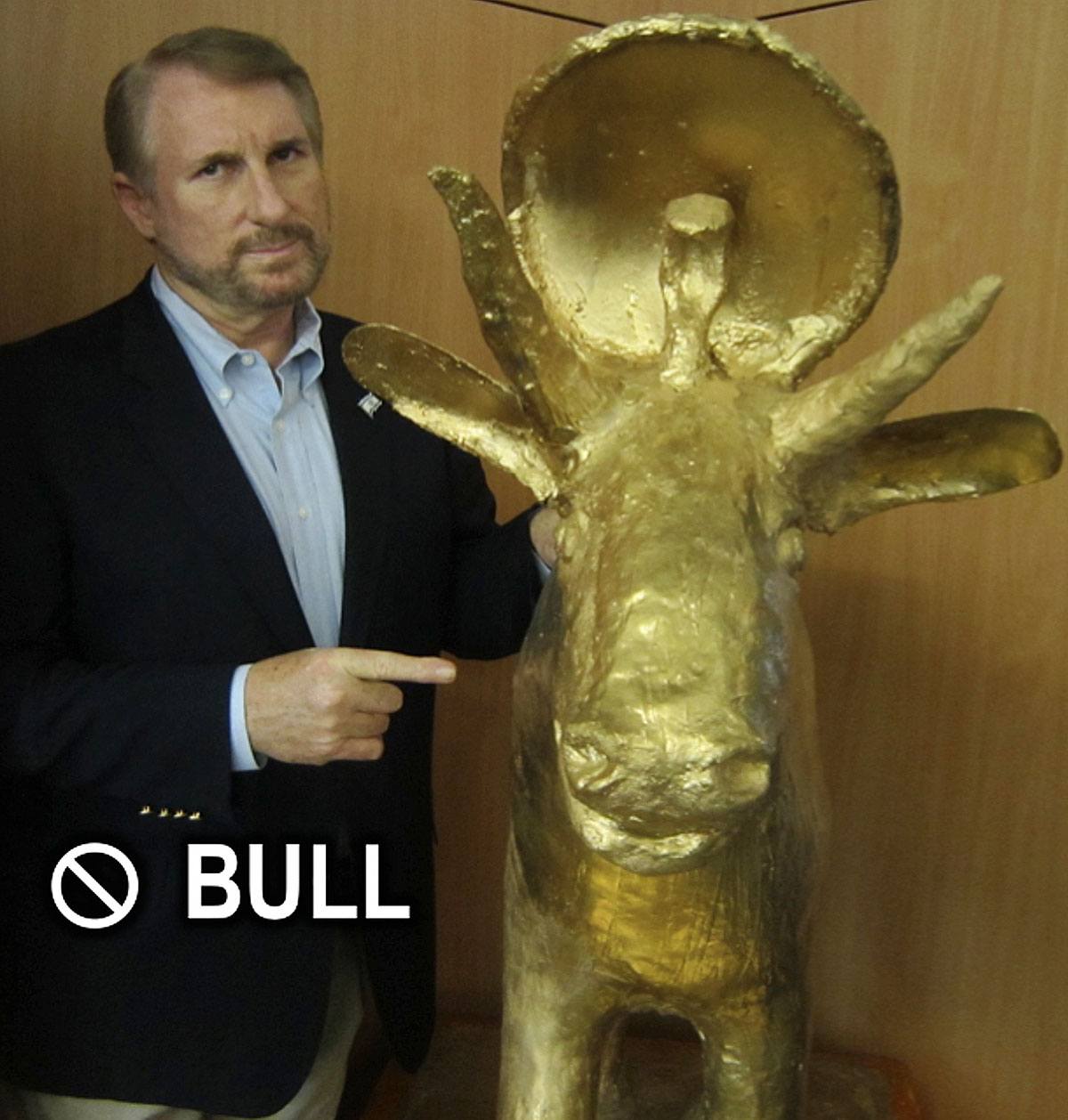
“They have quickly turned aside from the way which I commanded them. They have made for themselves a molten calf, and have worshiped it, and have sacrificed to it, and said, ‘This is your God, O Israel, who brought you up from the land of Egypt!’” (Exodus 32:8)
In Exodus 32, the Hebrews, due to their provider and protector Moses’ long delay on Mt. Sinai, are depicted as in a frenzy, some assuming he had deserted them or that he had died on the fiery mountain. As a result they pressured Aaron to make for them “a god” to go before them in the place of Moses, the mediator with God, so they can successfully return to Egypt (vs. 1). Aaron then fashioned the image of a calf from some of the Egyptian gold jewelry that was intended for the construction of the Tabernacle and God’s worship within it (Ex. 11:2; 12:35-36). He then said to the people: “This is your God, O Israel, who brought you up from the land of Egypt” (vs. 4). Whether Aaron cast a molten image or applied beaten sheets of gold to a wooden image, the calf image and its worship by Israel is viewed as idolatry that threatens the covenant relationship between the LORD and His new Nation. Even if Aaron understood the calf as a symbol for YHWH, indicated by his building an altar (the usual practice after the manifestation of deity) and calling for a “sacred feast” to YHWH, this in no way mitigated his guilt since it was a violation of the first commandment, which is why this incident in Hebrew is known as ḥēṭ’ ha’ēggel (“the Sin of the Calf”).
There has been considerable speculation as to the choice of a calf image, especially since Jeroboam used this same figure, including the repetition of Aaron’s declaration, as justification to Israel when he later installed them in worship centers in Dan and Bethel (1 Kgs. 12:28-29). Since the Hebrews had asked for the representation of a god to escort them back to Egypt, it is assumed that the image was of an Egyptian deity. The ten plagues had been ultimately directed against the gods of Egypt, and the fifth plague (Ex. 9:2-4) had been against livestock, including cattle, whose strength and fertility had symbolized several of the Egyptian deities. Some proposals have been Mnevis, the sacred bull of Heliopolis, Apis (or Hapis), a sacred bull that served as an intermediary between humans and other powerful deities such as Ptah, Osiris, and Atum, and even the Canaanite fertility god Ba’al. However, there are clues in the biblical account that suggest Aaron modeled his image after the Egyptian mother-goddess Hathor who appeared in the form of a cow or a woman wearing a headdress of cow horns and a sun disk.
Hathor was a primary deity in the pantheon of Ancient Egypt and one of the most widely worshipped deities in Egypt and other lands, including Canaan (as witnessed by a shrine to Hathor in the Timna Valley). She was the symbolic mother of the gods’ earthly representatives, the pharaohs. Moreover, the pharaoh was considered to be the earthly incarnation of Ra, the king of the gods, and Hathor was the Eye of Ra and Ra’s feminine counterpart and in this form protected him from his enemies. She was also one of the deities who were commonly prayed to for help with personal problems. Called the mistress of music, dance, drunkenness and sexuality, her annual festivals were often celebrated with drinking and dancing for a ritual purpose. By comparison, the Hebrews obviously desired protection for their return trip and to be received by the Egyptians. Returning under the aegis of pharaoh’s own divine protector would serve as a call for the pharaoh to act benevolently. Also, in the Exodus account, the creation of the calf image and the erection of an altar (for ritual purpose) is celebrated by frivolity (“they rose up to play”), a term which has a connotation of sexual play (Gen 26:6–11; 39:6c–20).
We may add to the evidence above the possibility that Hathor was associated with YHWH because of Moses’ Egyptian mother Queen Hatshepsut (according the early date view). during the Middle Kingdom Egyptian queens were seen as directly embodying the goddess Hathor in the same way the pharaoh embodied Ra. However, she was the daughter, sister, and wife of a pharaoh and during the New Kingdom’s 18th dynasty for a time she ruled jointly with Thutmosis III (pharaoh of the Oppression), until he grew old enough to succeed her. Archaeology has revealed the mortuary temple of the Queen in
It is against this background of confusion between creator and created that the meaning of the golden calves can be understood. At one moment Amon-Re is the hidden, invisible, ineffable, almighty God. But at precisely the same instant he is the life force so powerfully portrayed in the strength and sexual prowess of the Bull. He is the invisible God and he is the Bull. In the
Great Hymn to Amon12 he is called the “Bull of his mother” signifying his power of self- recreation (1: 3) and also his power to create all mankind (X: 8, 9). In the opening line of that hymn he is called the “Bull, chief of all the gods.” He is also called the “Bull of the Ennead”, that is, creator of the gods (1: 6). Other, similar, references may be found in the Leiden Hymn, the Tura Hymn and the Hymn of Nesichons.13 However, in the same contexts, Amon-Re is referred to in what seem to be the most transcendent terms. He is the unique One (VI: 2). His shrine, his ultimate home, is hidden (IV: 1). His power is limitless (III: 7, 8). He is the source of life and truth (III: 3-8). Similar references abound in the other religious literature. The Egyptian was able, then, to move between these conceptions with freedom.14 Thus, if Moses communed with the invisible Yahweh on the mountain top, his people understood themselves to be worshipping the visible Yahweh in the valley below. To people born and reared in Egypt there could never be a conflict between these conceptions. It was this God who had brought them out of bondage. This was no foreign god, no idol, it was Yahweh! Nor, on the other hand, was the young bull simply a pedestal. If in Egypt the Supreme God was at once transcendent in space and immanent in the Bull, it is only natural that the Hebrew people, especially at the moment of their wanting to return to Egypt, should conceive of Yahweh in the same terms. In this context, it cannot be only coincidence that it was in Egypt that Jeroboam spent several years in exile before assuming the kingship of North Israel. To one steeped in Egyptian thought there is nothing wrong about representing the supreme God as a Bull; in fact, there is something supremely right. Given the borrowings from pagan temples to be found in the structure and fittings of the Jerusalem temple,15 Jeroboam perhaps felt entirely justified in his actions. However, if Jeroboam and the descendants of Jacob saw nothing wrong in the worship of the Bull as Yahweh, Moses and the prophets did. They knew that the distinction between creator and created was of critical importance. To worship Yahweh the Invisible and Yahweh the Bull was to doom themselves to return on the way they had come, back to the leeks and garlic, back to the animism and black magic. To worship Yahweh the invisible only was to begin to prepare the way, to begin to flatten the hills and to fill in the valleys, until one day that One from outside the system could step into the system to redeem the system.
John N. Oswalt, “The Golden Calves and the Egyptian Concept of Deity,” Evangelical Quarterly 45.1 (January-March 1973): 16.
- Geraldine Pinch, Votive Offerings to Hathor (Griffith Institute, 1993), 349–351
- Ragnhild Finnestad, “Enjoying the Pleasures of Sensation: Reflections on A Significant Feature of Egyptian Religion” in Teeter, Emily; Larson, John A. (eds.), Gold of Praise: Studies on Ancient Egypt in Honor of Edward F. Wente (Oriental Institute of the University of Chicago, 1999), 113–115.
